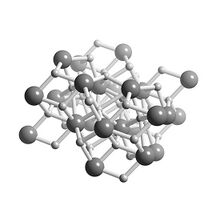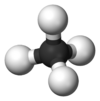Chemistry:Calcium hydride

| |
| Names | |
|---|---|
| IUPAC name
Calcium hydride
| |
| Other names
Calcium(II) hydride
Calcium dihydride Hydrolith | |
| Identifiers | |
3D model (JSmol)
|
|
| ChemSpider | |
| EC Number |
|
PubChem CID
|
|
| UNII | |
| |
| |
| Properties | |
| CaH 2 | |
| Molar mass | 42.094 g/mol |
| Appearance | gray powder (white when pure) |
| Density | 1.70 g/cm3, solid |
| Melting point | 816 °C (1,501 °F; 1,089 K) |
| reacts violently | |
| Solubility | reacts in alcohol |
| Structure | |
| Orthorhombic, oP12 | |
| Pnma, No. 62 | |
| Thermochemistry | |
Std molar
entropy (S |
41.4 J·mol−1·K−1[1] |
Std enthalpy of
formation (ΔfH⦵298) |
−181.5 kJ·mol−1 |
Gibbs free energy (ΔfG˚)
|
-142.5 kJ/mol |
| Hazards | |
| GHS pictograms |    
|
| GHS Signal word | DANGER |
| H260 | |
| NFPA 704 (fire diamond) | |
| Related compounds | |
Other cations
|
Sodium hydride, Potassium hydride Magnesium hydride |
Except where otherwise noted, data are given for materials in their standard state (at 25 °C [77 °F], 100 kPa). | |
| Infobox references | |
Calcium hydride is the chemical compound with the formula CaH
2, and is therefore an alkaline earth hydride. This grey powder (white if pure, which is rare) reacts vigorously with water liberating hydrogen gas. CaH
2 is thus used as a drying agent, i.e. a desiccant.[2]
CaH
2 is a saline hydride, meaning that its structure is salt-like. The alkali metals and the alkaline earth metals heavier than beryllium all form saline hydrides. A well-known example is sodium hydride, which crystallizes in the NaCl motif. These species are insoluble in all solvents with which they do not react. CaH
2 crystallizes in the PbCl
2 (cotunnite) structure.[3]
Preparation
Calcium hydride is prepared from its elements by direct combination of calcium and hydrogen at 300 to 400 °C.[4][5]
Uses
Reduction of metal oxides
CaH
2 is a reducing agent for the production of metal from the metal oxides of Ti, V, Nb, Ta, and U. It is proposed to operate via its decomposition to Ca metal:[4]
- TiO
2 + 2 CaH
2 → Ti + 2 CaO + 2 H
2
Hydrogen source
CaH
2 has been used for hydrogen production. In the 1940s, it was available under the trade name "Hydrolith" as a source of hydrogen:
'The trade name for this compound is "hydrolith"; in cases of emergency, it can be used as a portable source of hydrogen, for filling airships. It is rather expensive for this use.'[6]
The reference to "emergency" probably refers to wartime use. The compound has, however, been widely used for decades as a safe and convenient means to inflate weather balloons. Likewise, it is regularly used in laboratories to produce small quantities of highly pure hydrogen for experiments. The moisture content of diesel fuel is estimated by the hydrogen evolved upon treatment with CaH2.[4]
Desiccant
The reaction of CaH
2 with water can be represented as follows:
- CaH
2 + 2 H
2O → Ca(OH)
2 + 2 H
2
The two hydrolysis products, gaseous H
2 and Ca(OH)
2, are readily separated from the dried solvent.
Calcium hydride is a relatively mild desiccant and, compared to molecular sieves, probably inefficient.[7] Its use is safer than more reactive agents such as sodium metal or sodium-potassium alloy. Calcium hydride is widely used as a desiccant for basic solvents such as amines and pyridine. It is also used to dry alcohols.[2]
Despite its convenience, CaH
2 has a few drawbacks:
- It is insoluble in all solvents with which it does not react vigorously, in contrast to LiAlH
4, thus the speed of its drying action can be slow. - Because CaH
2 and Ca(OH)
2 are almost indistinguishable in appearance, the quality of a sample of CaH
2 is not obvious visually.
History
During the Battle of the Atlantic, German submarines used calcium hydride as a sonar decoy called bold.[8]
Other calcium hydrides
Although the term calcium hydride almost always refers to CaH2, a number of molecular hydrides of calcium are known. One example is (Ca(μ-H)(thf)(nacnac)2.[9]
See also
References
- ↑ Zumdahl, Steven S. (2009). Chemical Principles 6th Ed. Houghton Mifflin Company. p. A21. ISBN 978-0-618-94690-7.
- ↑ 2.0 2.1 Gawley, Robert E.; Davis, Arnold (2001). "Calcium Hydride". Encyclopedia of Reagents for Organic Synthesis. doi:10.1002/047084289X.rc005. ISBN 0471936235.
- ↑ Wells, A.F. (1984) Structural Inorganic Chemistry, Oxford: Clarendon Press. ISBN:0-19-855370-6.
- ↑ 4.0 4.1 4.2 Rittmeyer, Peter; Wietelmann, Ulrich (2000). "Ullmann's Encyclopedia of Industrial Chemistry". Ullmann's Encyclopedia of Industrial Chemistry. Weinheim: Wiley-VCH. doi:10.1002/14356007.a13_199.
- ↑ P. Ehrlich (1963). "Calcium Strontium and Barium Hydrides". in G. Brauer. Handbook of Preparative Inorganic Chemistry, 2nd Ed.. 1. NY, NY: Academic Press. pp. 929.
- ↑ Adlam G.H.J. and Price L.S., A Higher School Certificate Inorganic Chemistry, John Murray, London, 1940
- ↑ Williams, D. Bradley G.; Lawton, Michelle (2010). "Drying of Organic Solvents: Quantitative Evaluation of the Efficiency of Several Desiccants". The Journal of Organic Chemistry 75 (24): 8351–8354. doi:10.1021/jo101589h. PMID 20945830.
- ↑ McNeil, Ian (2002-06-01). An Encyclopedia of the History of Technology. Routledge. ISBN 9781134981649. https://books.google.com/books?id=-sXFBQAAQBAJ.
- ↑ Mukherjee, Debabrata; Schuhknecht, Danny; Okuda, Jun (2018). "Hydrido Complexes of Calcium: A New Family of Molecular Alkaline-Earth-Metal Compounds". Angewandte Chemie International Edition 57 (31): 9590–9602. doi:10.1002/anie.201801869. PMID 29575506.
 |









